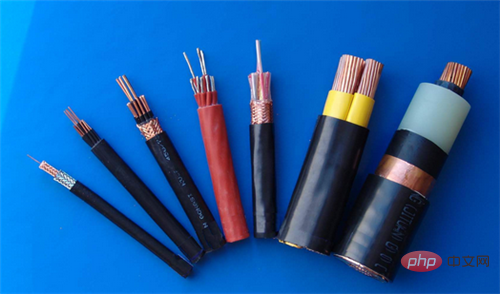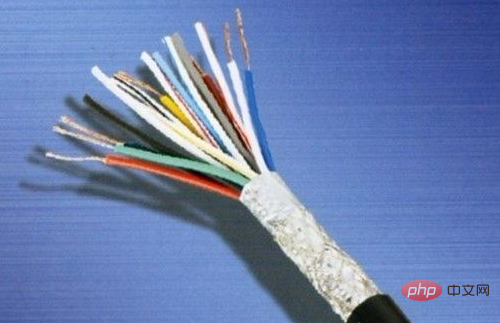What cable is kvv?
KVV cable is a kind of polyvinyl chloride insulated control cable, mostly used for control, signal, protection and measurement system wiring; its rated voltage is 450/750V or 0.6/1kV. If the conductors in KVV cables work for a long time, the maximum operating temperature cannot exceed 70 degrees, and the laying environment temperature cannot be lower than zero. If you want to work in a sub-zero environment, you must preheat it first.

The operating environment of this tutorial: Windows 7 system, Dell G3 computer.
KVV cable is a kind of polyvinyl chloride insulated control cable, which is mostly used for control, signal, protection and measurement system wiring. It is manufactured according to standards such as GB9330 "Plastic Insulated Control Cables", IEC60227 "Polyvinyl Chloride Insulated Cables with Rated Voltage 450/750V and Below" and IEC60502 "Extruded Insulated Power Cables with Rated Voltage 1-30kV and Accessories".
1. KVV cable is a control cable, which is what we often call PVC insulated control cable. Generally used for wiring on control, signal and measurement systems.
2. Its rated voltage is 450/750V or 0.6/1kV.
3. If the conductor works for a long time, the maximum working temperature cannot exceed 70 degrees, and the laying environment temperature cannot be lower than zero. If you want to work in a sub-zero environment, you must preheat it first.
4. Allowable bending radius: ① The allowable bending radius of unarmored cables is 6 times the outer diameter or more. ②The allowable bending radius of armored or copper-tape shielded cables is 12 times the outer diameter. ③The allowable bending radius of shielded flexible cables is also 6 times or more of the outer diameter.
5. Laying scope: suitable for fixed occasions, such as indoors, cable trenches and pipelines.

Usage characteristics
The power frequency rated voltage Uo/U is 450/750V.
The maximum allowable long-term operating temperature of the cable conductor is 70°C.
The ambient temperature when laying cables should not be lower than 0℃. If the ambient temperature is lower than 0℃, the cables should be preheated.
-
The recommended allowable bending radius of cables is as follows:
For unarmored cables, it should be no less than 6 times the outer diameter of the cable;
Armored or copper tape shielded cables should be no less than 12 times the outer diameter of the cable;
Shielded flexible cables should be no less than the outer diameter of the cable 6 times the outer diameter.

How to choose the cable
1. Model selection
(1) You can choose the model based on the usage, laying conditions and safety.
(2) Depending on the use, power cables, control cables, insulated cables, etc. can be selected.
(3) From the perspective of laying conditions, general plastic insulation, armored cables, anti-corrosion cables, etc. can be selected.
(4) From the perspective of safety, flame retardant cables, fire-resistant cables, halogen-free flame retardant cables, etc. can be selected.
2. Selection of specifications
(1) What specifications to use should consider whether the cable is prone to heat, the voltage loss during operation and the mechanical strength of the wire itself, etc.
(2) If it is a low-voltage power line, choose it from the perspective of heating, because it carries a large current, and then consider the voltage loss and mechanical strength.
(3) For high-voltage lines, the current density is first of all, followed by heat generation and voltage loss.
For more related knowledge, please visit the FAQ column!
The above is the detailed content of What cable is kvv?. For more information, please follow other related articles on the PHP Chinese website!

Hot AI Tools

Undresser.AI Undress
AI-powered app for creating realistic nude photos

AI Clothes Remover
Online AI tool for removing clothes from photos.

Undress AI Tool
Undress images for free

Clothoff.io
AI clothes remover

AI Hentai Generator
Generate AI Hentai for free.

Hot Article

Hot Tools

Notepad++7.3.1
Easy-to-use and free code editor

SublimeText3 Chinese version
Chinese version, very easy to use

Zend Studio 13.0.1
Powerful PHP integrated development environment

Dreamweaver CS6
Visual web development tools

SublimeText3 Mac version
God-level code editing software (SublimeText3)

Hot Topics
 What kind of cable is yc cable?
Nov 15, 2022 pm 04:29 PM
What kind of cable is yc cable?
Nov 15, 2022 pm 04:29 PM
YC cable refers to heavy-duty general rubber-sheathed cable, Y represents rubber insulation, C represents heavy-duty cable; YC cable is suitable for household appliances, power tools and various mobile electrical equipment or light mobile electrical equipment with AC rated voltage below 450/750V, or It is used for temporary construction on construction sites and can withstand large mechanical external forces.
 my country's optical fiber giant YOFC acquires RFS's German and Suzhou companies to develop the international cable market
Apr 09, 2024 am 10:40 AM
my country's optical fiber giant YOFC acquires RFS's German and Suzhou companies to develop the international cable market
Apr 09, 2024 am 10:40 AM
According to news on April 9, YOFC Optical Fiber and Cable Co., Ltd. (hereinafter referred to as "YOFC") recently acquired the German and Suzhou companies of Radio Frequency Systems GmbH (hereinafter referred to as "RFS") and held a delivery ceremony. As a provider of optical fiber preforms, optical fibers, optical cables and comprehensive solutions, YOFC mainly produces and sells various standard specifications of optical fiber preforms, optical fibers and optical cables widely used in the communications industry, as well as various types of optical modules and special optical modules based on customer needs. Optical fibers, active optical cables, submarine cables, as well as radio frequency coaxial cables, accessories and other products. In recent years, we have vigorously expanded markets such as rail transit, base station cables and devices, and power cables. According to reports, the RFS German and Suzhou companies acquired in this transaction are engaged in activities including radio frequency cables.
 What does it mean when a network cable is pulled out?
Nov 13, 2022 pm 02:34 PM
What does it mean when a network cable is pulled out?
Nov 13, 2022 pm 02:34 PM
The network cable being pulled out means that the network cable plugged into the computer has been pulled out. The solution is: 1. Check the network cable and plug it in; 2. Check the Internet access device and turn on the modem power; 3. Check the computer network cable interface And confirm the connection; 4. Check whether the network card is damaged; 5. Check whether the network card is disabled and enable it.
 What cable is ng-a?
Oct 09, 2022 pm 01:42 PM
What cable is ng-a?
Oct 09, 2022 pm 01:42 PM
NG-A is "mineral insulated fireproof cable". NG-A cable is a new generation of mineral insulated cable developed on the basis of BTTZ cable. In addition to the advantages of BTTZ cable, it also overcomes the problems and defects of BTTZ cable. It can overcome the defects of rigid fire-proof cables and give full play to the advantages of flexible fire-proof cables. Advantages, providing practical products for key projects.
 What cable is kvv?
Nov 14, 2022 pm 01:40 PM
What cable is kvv?
Nov 14, 2022 pm 01:40 PM
KVV cable is a polyvinyl chloride insulated control cable, mostly used for control, signal, protection and measurement system wiring; its rated voltage is 450/750V or 0.6/1kV. If the conductors in KVV cables work for a long time, the maximum operating temperature cannot exceed 70 degrees, and the laying environment temperature cannot be lower than zero. If you want to work in a sub-zero environment, you must preheat it first.
 How to solve the problem when the network cable is pulled out
Jan 02, 2024 am 09:55 AM
How to solve the problem when the network cable is pulled out
Jan 02, 2024 am 09:55 AM
Solution: 1. Check the network cable connection and ensure that the connection between the network cable and the router and modem is normal; 2. Re-plug and unplug the network cable and try to re-plug and unplug the network cable; 3. Check the crystal head and try to replace the crystal head; 4. Check the network card driver program, try to update the network card driver, or reinstall the network card driver; 5. Check the computer system settings, check the computer network settings, and ensure that the settings are correct; 6. Check the network hardware, try to check the connection status of the router, or contact the network service provider business.
 What to do if the laptop display cable is pulled out
Jan 20, 2021 pm 02:11 PM
What to do if the laptop display cable is pulled out
Jan 20, 2021 pm 02:11 PM
Solution to the laptop display cable being pulled out: 1. Open the device manager and find the network adapter; 2. Double-click to open the network card properties panel and switch to the advanced column; 3. Set the value of the [energy efficient ethernet] attribute to disabled. .
 What does it mean when the local area connection network cable is unplugged?
Feb 28, 2023 pm 03:43 PM
What does it mean when the local area connection network cable is unplugged?
Feb 28, 2023 pm 03:43 PM
The local connection network cable being pulled out means that the network cable is not plugged in properly, the network connection is disconnected, just reconnect it; the network cable is the medium for transmitting information from one network device to another, and is the basis of the network. member.





